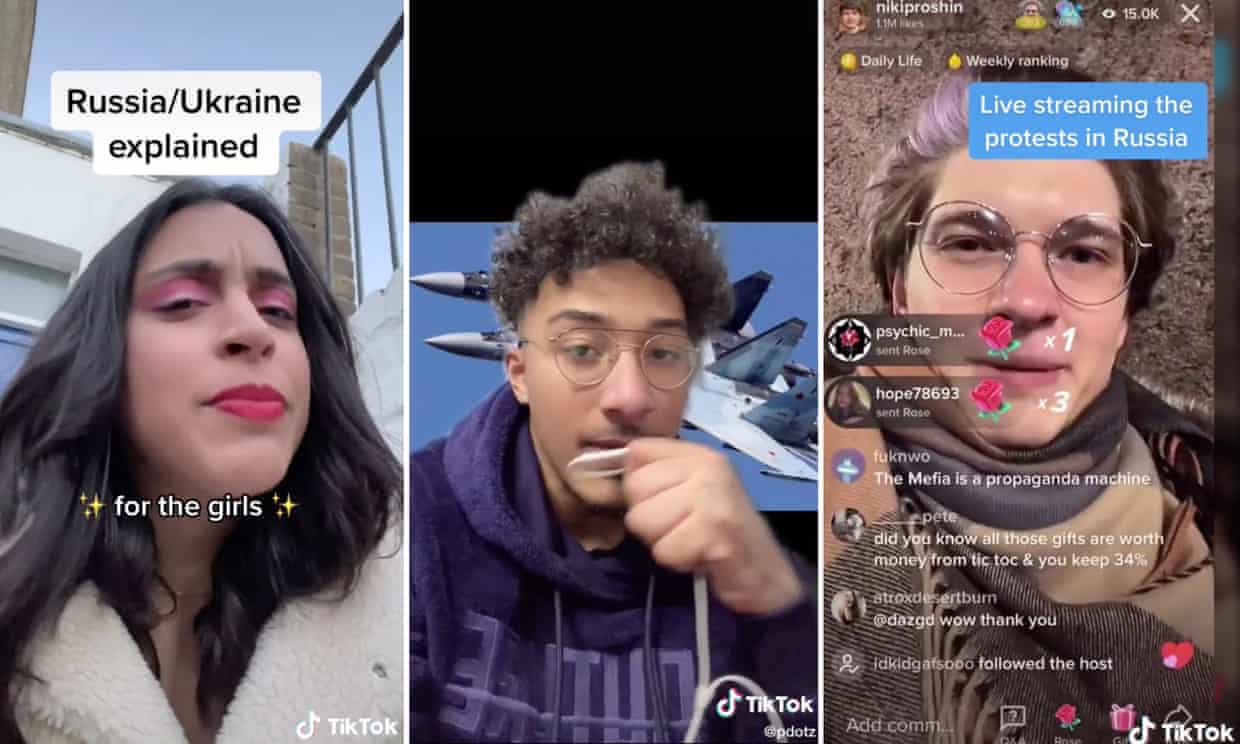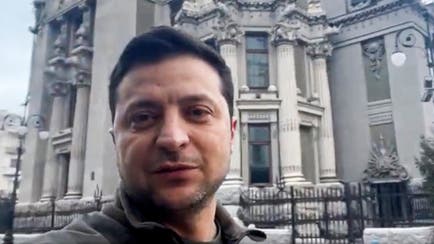War as seen on TikTok: Ukraine clips get views whether true or not
Social media platform is a popular news source for young adults, but misinformation is commonplace

"Trucks carrying large cylindrical containers sweep down a snowy road to a soundtrack of hollering and an alarming, if amateurish, caption: “RUSIA NUCLEAR BOMB”. The video was taken down, but not before it received 18m views. Welcome to the Russia-Ukraine conflict on TikTok. . .
> A London-based TikToker, Nikita Redkar, has received nearly 3m views for her tongue-in-cheek clip describing the conflict like a relationship breakdown: “Back in the 90s Russia and Ukraine used to be a thing but things got really messy and they broke up.” An even more popular follow-up post, captioned “Will there be a WW3?” continues with the theme, describing NATO as a “group of besties” who cannot support Ukraine because “you don’t roll with the crew”.
> Pdotz, a popular British TikToker with more than half a million followers, has received about 3m views for his explainers on the conflict. . .
[. ] A TikTok spokesperson said: “We continue to respond to the war in Ukraine with increased safety and security resources to detect emerging threats and remove harmful misinformation and other violations of our community guidelines. We also partner with independent factchecking organisations to support our efforts to help TikTok remain a safe and authentic place.”
TikToks about misinformation, and how to spot it, are also proving popular. Abbie Richards, a TikToker with 536,000 followers who regularly posts on misinformation, has received more than half a million views for her guide to spotting false videos – including overdubbed audio and recycling old footage. Old footage has proved popular. One video captioned “Ukrainian soldiers saying goodbye to their families” has had 2.8m views but is clearly footage of US soldiers and their loved ones. Video game footage has also been adapted, with one clip purportedly showing a Ukrainian jet downing a Russian fighter – which has had nearly 10m views and is still live – but can be traced to a YouTube video made on a flight simulator game. The ITV News TikTok account is posting regularly on Ukraine and is garnering up to 400,000 views for its posts, but pales in comparison with less expert accounts with the same, or fewer, followers.
There is nothing unusual about TikTok’s algorithm compared with other platforms, according to Julian McAuley, a professor of computer science at the University of California, San Diego. “TikTok uses fairly ‘standard’ recommendation technology that will mostly recommend content that’s consistent with what users have previously engaged with. If users frequently consume misinformation (or slanted content), they’re likely to see more of it.” . .
READ MORE >> https://www.theguardian.com/technology/2022/mar/05/tiktok-ukraine-russia-invasion-clips-get-views-whether-true-or-not
=========================================================================
RELATED CONTENT and this additional observation: There has also been plenty of racism in the Ukraine coverage, with a media industry ― still very white ― expressing more sympathy for what Ukrainians are going through because they look like them.
The Media Are Still Clinging To Their Hawkish, Pro-War Tendencies
Please don't push us into a nuclear war!

In 2003, the United States launched an invasion of Iraq based on government lies, fueled by eager media personalities who were far too willing to parrot what officials were telling them.
It wasn’t just that they valued access and were buddies with their sources. There was also too often a mainstream willingness to accept that showing strength and power was important for a country like America, and the best way to do that was to go win a war.
Of course, things didn’t go as planned. It wasn’t quick. We weren’t greeted as liberators. And there was no “mission accomplished,” as President George W. Bush so famously, and prematurely, declared in June 2003.
Plenty has changed since then. There’s far more questioning, on both sides of the aisle, about whether the United States needs to jump in and fix all the world’s problems with boots on the ground.
But some things remain, such as the media’s tendency to embrace their hawkish side. And it’s been creeping into the coverage of Russia’s invasion of Ukraine.
Some high-profile media figures have pushed bellicose, and even reckless, rhetoric over the past week, suggesting to varying degrees that America should take steps that would almost inevitably lead to war with Russia. . .
Despite some of these discouraging tendencies by some members of the media, the environment is very different from what it was in 2003. It’s much more diffuse, and troubling comments ― whether ones that make light of getting U.S. troops involved in a wider conflict or racist characterizations ― have been quickly called out on social media.
On Tuesday morning, the former U.S. ambassador to Russia, Michael McFaul ― who is a frequent presence on MSNBC ― played into the good vs. evil frame, tweeting that there are no more “innocent” or “neutral” Russians now. . .McFaul later deleted that tweet after receiving heavy criticism.
NBC News chief foreign correspondent Richard Engel suggested that by not attacking a massive Russian convoy of tanks and armored vehicles outside Ukraine’s capital, the United States and other countries were watching “in silence.”
Clint Watts, a former FBI agent and MSNBC contributor similarly tweeted that more needed to be done about the massive Russian convoy outside Ukraine’s capital ― and called doubts about more intervention “handwringing.”
And Fox News host Sean Hannity simply said, “Why isn’t there some group ― nobody has to take credit for it ― I believe in covert operations and plausible deniability. They’re sitting ducks. Why don’t we take out that convoy?”
On Monday, a New York Post editorial headline read, “West Must Consider Intervening to Stop a Slaughter in Ukraine.”
NBC host Chuck Todd thought Biden should’ve turned it into a wartime speech, wondering why he didn’t devote significantly more time to talking about the European crisis ― despite all the economic and other issues that America has to deal with at home. (For the record, Biden led his remarks with Ukraine and spent about 12 minutes on the topic in a speech that lasted just over an hour.)
Todd said he thought Biden would “spend a little more time explaining why it is our fight, as you said, ‘good versus evil,’ explain a little bit more and a little bit of the history of the defense of Europe, and why we’re in this position.”


No comments:
Post a Comment